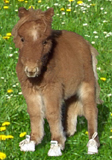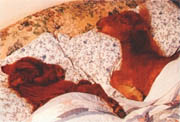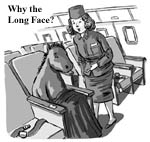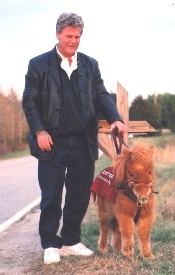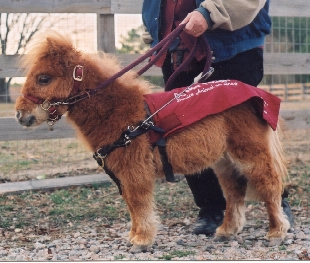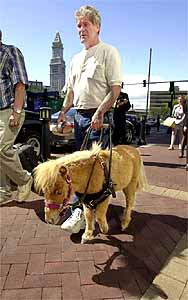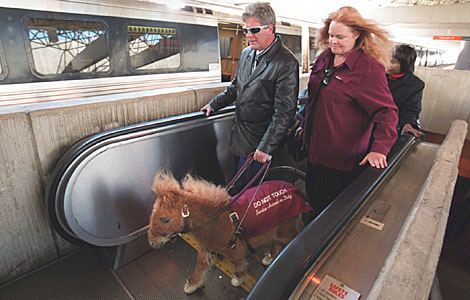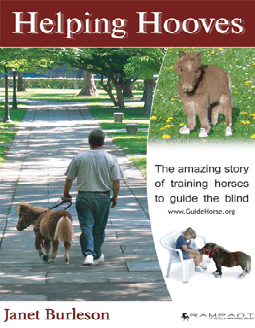When I was 17, a routine visit to the doctor changed my
life. My doctor told me I had retinitis pigmentosa, an
incurable eye disease that would render me completely blind
by the time I reached middle age. Every year thereafter, I
felt my disease closing in. First I couldn’t drive, then I
couldn’t read; I knew it was only a matter of time before I
was engulfed in perpetual darkness.
| |
 |
|
| |
Cuddles gave me back my independence and, more
important, a reason to talk to people |
|
By
four years ago, my sight had deteriorated so much that I
decided to enter a school for the blind to learn how to live
with my disability—how to cook, how to read Braille, how to
make the most of my other senses. During my stay I realized
that many of the other students kept themselves isolated,
hesitating even to leave the safety of the dorms. That
really scared me. I desperately wanted to keep contact with
the world.
But I was shocked at how few options I had. I didn’t
want to struggle with a white cane, and I couldn’t bear the
idea of having a guide dog because of the grief I had
experienced when my beloved pet dog died 10 years before. I
knew I’d feel the loss of an animal I had relied on for my
independence even more acutely.
Then I heard about an experimental new program conducted
by Janet and Don Burleson. The Burlesons were training
miniature horses as guides and hoping to match one of them
with a blind person. When I learned that these horses live
much longer than dogs (30 to 40 years), I was intrigued. The
Burlesons scheduled me to work with a young mare named
Cuddles.
I was about to become the world’s first user of a guide
horse. I knew that there would be skeptics—people who didn’t
believe horses had the right temperament to be service
animals. After all, in the 1920s, when Dorothy Eustis began
training German shepherds to lead the blind, many people
scoffed at the idea. But I knew that getting my independence
back would outweigh any criticism.
I flew to North Carolina to meet Cuddles. Our first
outing was to a pet store. Despite the noise from the other
animals, Cuddles stayed calm and led me up and down the
aisles. I didn’t bump into a thing. As we left the store I
cried tears of joy; I could now go anywhere with ease.
Two days later, I took my first flight with Cuddles. I
was nervous because I had heard a recent news story about a
service pig that had misbehaved on a commercial airliner.
There were newspaper and television reporters on the plane
with us, all clutching their notebooks and cameras and
secretly hoping that Cuddles would cause a disturbance. They
must have been disappointed when she stood next to me and
slept for almost the whole trip.
Having a guide horse has changed every aspect of my
life. If my wife, Anne, takes me to the mall and we split up
to do our shopping, Cuddles can lead me to the car when it’s
time to go. Cuddles and I even go out alone for long walks
in the woods. She can see in almost total darkness and
responds to more than 25 voice commands. She is house
trained and will tap on the door with her hoof when she
needs to go outside.
Fortunately for me, Americans are extremely tolerant of
new ideas, and the negative reactions I feared I’d get from
strangers have been rare. Most people are curious and ask me
where I got Cuddles, how she was trained, what she eats.
I will never forget the time that Cuddles and I went to
New York City together. We successfully navigated even the
most dangerous intersections, and I felt at home because
most New Yorkers didn’t find a mini horse in sneakers (which
she wears for traction) to be the slightest bit unusual.
Even on the subway at rush hour, Cuddles and I packed into
the train right alongside the weary commuters. From the
Carnegie Deli to the top of the Empire State Building, I
felt free for the first time in more than 20 years.
I have always been a rebel, and as an ex-biker I
have many tattoos. I suppose it is only fitting that I was
given a horse named Cuddles. I had a tattoo of her placed on
the back of my hand. I may not be as tough or macho as I
used to be, but with Cuddles I have as much self-confidence
as I ever did as a sighted person.
I have never regretted taking a risk and pioneering a
new concept. Today I live a full life. Owning such a unique
service animal gives me independence, but it also gives me a
reason to talk to people, a way to connect with the world.
Every time I hear the gasps of amazement from an onlooker
who has just realized that Cuddles is not a guide dog, I
smile.
Shaw runs a bait-and-tackle shop in Ellsworth, Maine.
© 2002 Newsweek, Inc.
|
